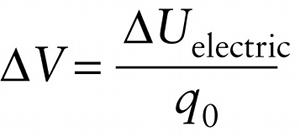Chapter 17. Electric potential difference related to electric potential energy difference (17-6)
Question
4jCI1qpoZSEIFheR0gOZ6N1lgiQfo3/G6da3Zfe0K5+Gv8WoC5Rymyikqcpp9V6H8lnP/VlRDI2/cnIUGQ3ElDVcAyI=
Question
lQmVZsD1iAysrLAFA8Y6hLRNWfCcKFlCoJCEE/brWR06r+enLAKcvcRe4BwKpFrWJCur+nohh8xBEYsgzjpffnF6aSN4gb8cWj9ervKsO5ALAKrJC9FGzuqZ1Q78mxgGyqX7ffwIU6hbNy9W0o3Xow==
Question
XNyoXR2DD9a4JQTF7SoYiLHRaFaWghzicQwmnN+z02nBicfJAQVWcw==
Review
For electric potential energy, the value of \(U_{\mathrm{electric}}\) for a charge at a given position is not as important as the potential energy difference \(\Delta{U}_{\mathrm{electric}}\) when the charge moves from a point \(a\) to a different point \(b\). The same is true for electric potential. From Equation 17-5, the electric potential difference \(\boldsymbol{\Delta{V}}\) between two points is
